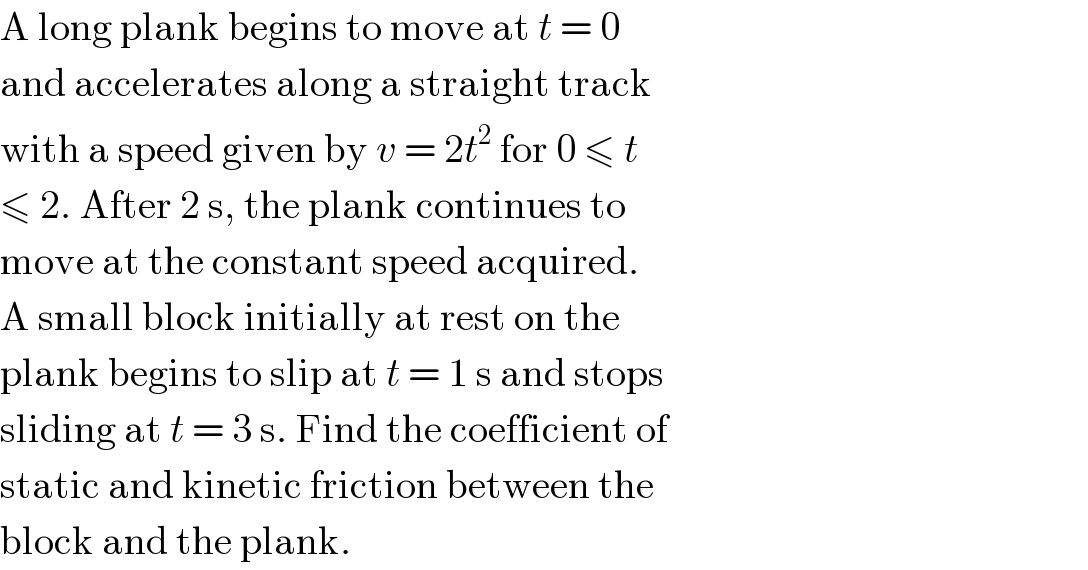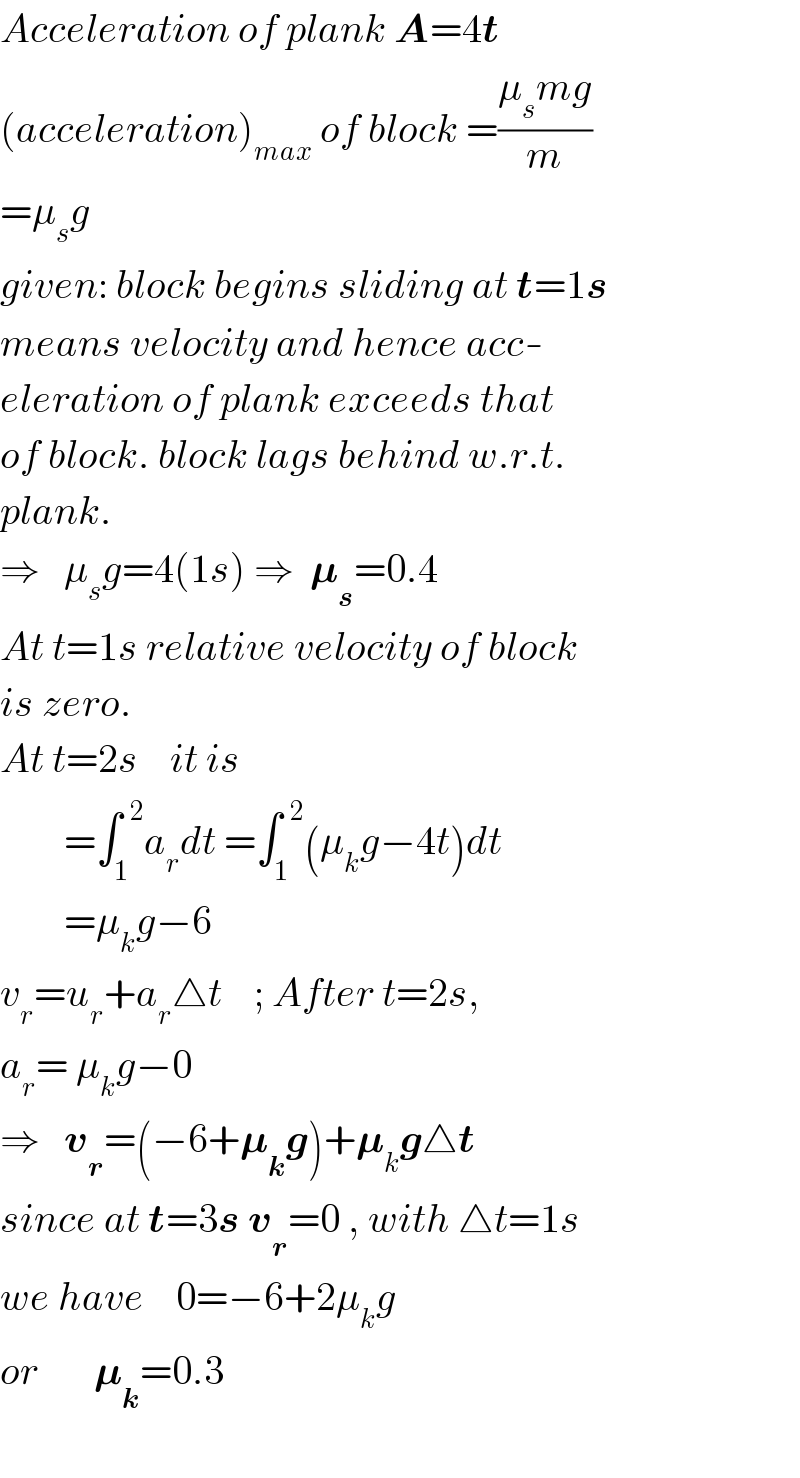
Question Number 22456 by Tinkutara last updated on 18/Oct/17

$$\mathrm{A}\:\mathrm{long}\:\mathrm{plank}\:\mathrm{begins}\:\mathrm{to}\:\mathrm{move}\:\mathrm{at}\:{t}\:=\:\mathrm{0} \\ $$$$\mathrm{and}\:\mathrm{accelerates}\:\mathrm{along}\:\mathrm{a}\:\mathrm{straight}\:\mathrm{track} \\ $$$$\mathrm{with}\:\mathrm{a}\:\mathrm{speed}\:\mathrm{given}\:\mathrm{by}\:{v}\:=\:\mathrm{2}{t}^{\mathrm{2}} \:\mathrm{for}\:\mathrm{0}\:\leqslant\:{t} \\ $$$$\leqslant\:\mathrm{2}.\:\mathrm{After}\:\mathrm{2}\:\mathrm{s},\:\mathrm{the}\:\mathrm{plank}\:\mathrm{continues}\:\mathrm{to} \\ $$$$\mathrm{move}\:\mathrm{at}\:\mathrm{the}\:\mathrm{constant}\:\mathrm{speed}\:\mathrm{acquired}. \\ $$$$\mathrm{A}\:\mathrm{small}\:\mathrm{block}\:\mathrm{initially}\:\mathrm{at}\:\mathrm{rest}\:\mathrm{on}\:\mathrm{the} \\ $$$$\mathrm{plank}\:\mathrm{begins}\:\mathrm{to}\:\mathrm{slip}\:\mathrm{at}\:{t}\:=\:\mathrm{1}\:\mathrm{s}\:\mathrm{and}\:\mathrm{stops} \\ $$$$\mathrm{sliding}\:\mathrm{at}\:{t}\:=\:\mathrm{3}\:\mathrm{s}.\:\mathrm{Find}\:\mathrm{the}\:\mathrm{coefficient}\:\mathrm{of} \\ $$$$\mathrm{static}\:\mathrm{and}\:\mathrm{kinetic}\:\mathrm{friction}\:\mathrm{between}\:\mathrm{the} \\ $$$$\mathrm{block}\:\mathrm{and}\:\mathrm{the}\:\mathrm{plank}. \\ $$
Answered by ajfour last updated on 18/Oct/17

$${Acceleration}\:{of}\:{plank}\:\boldsymbol{{A}}=\mathrm{4}\boldsymbol{{t}} \\ $$$$\left({acceleration}\right)_{{max}} \:{of}\:{block}\:=\frac{\mu_{{s}} {mg}}{{m}} \\ $$$$=\mu_{{s}} {g}\: \\ $$$${given}:\:{block}\:{begins}\:{sliding}\:{at}\:\boldsymbol{{t}}=\mathrm{1}\boldsymbol{{s}} \\ $$$${means}\:{velocity}\:{and}\:{hence}\:{acc}- \\ $$$${eleration}\:{of}\:{plank}\:{exceeds}\:{that} \\ $$$${of}\:{block}.\:{block}\:{lags}\:{behind}\:{w}.{r}.{t}. \\ $$$${plank}. \\ $$$$\Rightarrow\:\:\:\mu_{{s}} {g}=\mathrm{4}\left(\mathrm{1}{s}\right)\:\Rightarrow\:\:\boldsymbol{\mu}_{\boldsymbol{{s}}} =\mathrm{0}.\mathrm{4} \\ $$$${At}\:{t}=\mathrm{1}{s}\:{relative}\:{velocity}\:{of}\:{block} \\ $$$${is}\:{zero}. \\ $$$${At}\:{t}=\mathrm{2}{s}\:\:\:\:{it}\:{is} \\ $$$$\:\:\:\:\:\:\:\:=\int_{\mathrm{1}} ^{\:\:\mathrm{2}} {a}_{{r}} {dt}\:=\int_{\mathrm{1}} ^{\:\:\mathrm{2}} \left(\mu_{{k}} {g}−\mathrm{4}{t}\right){dt} \\ $$$$\:\:\:\:\:\:\:\:=\mu_{{k}} {g}−\mathrm{6} \\ $$$${v}_{{r}} ={u}_{{r}} +{a}_{{r}} \bigtriangleup{t}\:\:\:\:;\:{After}\:{t}=\mathrm{2}{s}, \\ $$$${a}_{{r}} =\:\mu_{{k}} {g}−\mathrm{0} \\ $$$$\Rightarrow\:\:\:\boldsymbol{{v}}_{\boldsymbol{{r}}} =\left(−\mathrm{6}+\boldsymbol{\mu}_{\boldsymbol{{k}}} \boldsymbol{{g}}\right)+\boldsymbol{\mu}_{{k}} \boldsymbol{{g}}\bigtriangleup\boldsymbol{{t}} \\ $$$${since}\:{at}\:\boldsymbol{{t}}=\mathrm{3}\boldsymbol{{s}}\:\boldsymbol{{v}}_{\boldsymbol{{r}}} =\mathrm{0}\:,\:{with}\:\bigtriangleup{t}=\mathrm{1}{s} \\ $$$${we}\:{have}\:\:\:\:\mathrm{0}=−\mathrm{6}+\mathrm{2}\mu_{{k}} {g} \\ $$$${or}\:\:\:\:\:\:\:\boldsymbol{\mu}_{\boldsymbol{{k}}} =\mathrm{0}.\mathrm{3} \\ $$$$\:\:\: \\ $$
Commented by Tinkutara last updated on 18/Oct/17

$$\mathrm{Thank}\:\mathrm{you}\:\mathrm{very}\:\mathrm{much}\:\mathrm{Sir}! \\ $$
